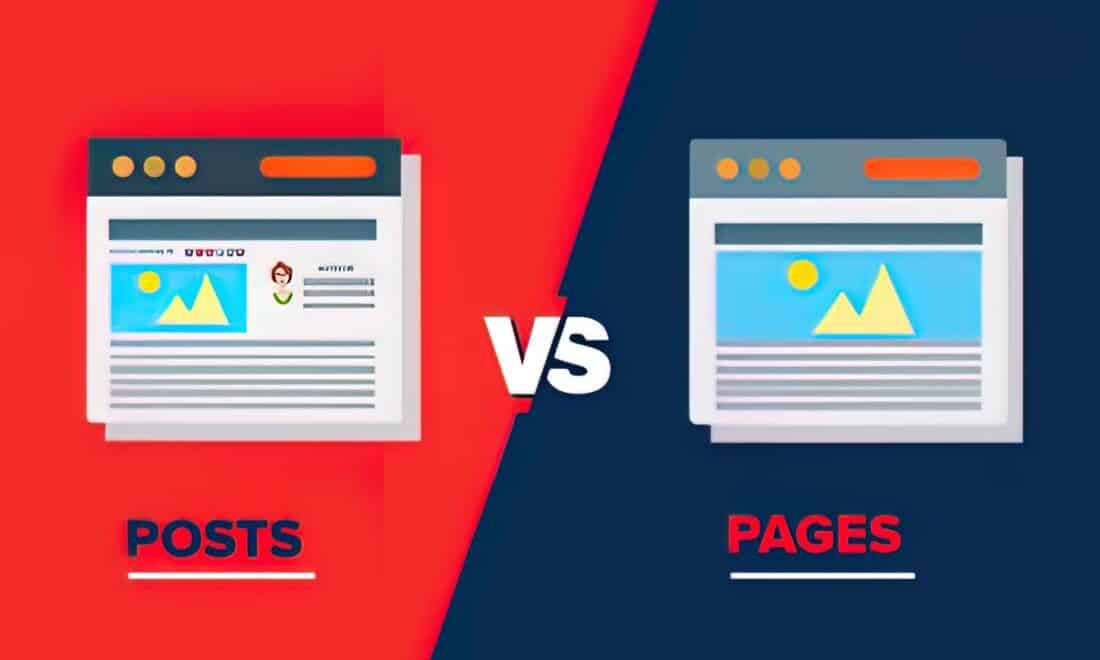Since its launch in May 2003, WordPress has become the most-used website platform globally. The WordPress platform powers almost 37% of the top 1 million trafficked websites, according to BuiltWith data.
Given the low cost (you really only pay for hosting), ease of installation and use and flexibility, WordPress is ready for websites of all sizes, from personal blogs to enterprise businesses.
I’ve worked on many WordPress websites, and one of the most common questions I still get is about pages versus posts – which one should be used?
Before answering that question, let’s review how WordPress pages and posts differ.
WordPress pages
Pages in WordPress are intended to hold content that may be considered more “evergreen,” such as the home page, product/service pages, or about us-type content.
Pages can be nested to create a directory structure by making one page the “parent” of another.
Generally, pages cannot leverage categories, tags and authors and are usually not included in RSS feeds from the website.
WordPress posts
Posts in WordPress link the platform back to its roots as a blogging platform. Posts were intended to hold news-related, time-sensitive, and other content that might be associated with websites that are strictly blogs.
Posts are time-driven and can leverage categories, tags, and authors for archive pages and on-site search. Posts are included in RSS feeds.
Content authors can make posts appear in a directory structure by setting up categories, which can be in parent/child relationships, and creating the structure in the Permalinks settings in the WordPress settings.
One crucial thing to remember: Both pages and posts are content for your users and the search engines.
The website owner sets their appearance and use. Pages and posts can be used interchangeably for any purpose – though it’s a terrible idea to mix similar content between the two formats.
| WordPress pages | WordPress posts |
| Intended for evergreen content | Intended for news or “blog” content – very time-driven |
| Can be nested together in parent/child arrangements to create a directory structure | Can fit into a directory structure using categories that can be nested in parent/child relationships |
| Cannot leverage categories, tags or authors | Leverages categories, tags, and authors |
| Cannot use RSS feeds to share content | Can use RSS feeds to share content |
| Can be styled any way the website owner wishes | Can be styled any way the website owner wishes |
| Is considered content to the website visitors and search engines | Is considered content to the website visitors and search engines |
Evolving recommendations
In the past, I most often recommended that “evergreen” content be created as pages. These would include items like the home page, product/service pages and “about us,” etc.
Other news-related, time-sensitive, instructive, blog-type content would be created as posts. As mentioned above, this follows what most consider the intention of pages and posts.
Although this way of working is still quite valid, I’ve been rethinking this advice lately.
Why?
A large number of websites I’ve worked on lately have had terrible information architecture.
For many of these sites, most, if not all, content is in the website’s root folder. Some sites have content on the same topic mixed between pages and posts. The former issue is relatively easy to fix, the latter, not so much.
Part of the problem is that WordPress is set to put all content at the website’s root by default. Another part is a misunderstanding of how pages and posts are intended to function.
My recommendations now are slightly different if a site is being built from scratch or undergoing a significant reorganization.
In that case, I have two recommendations based on the type of content that will comprise the majority of the website:
- For sites with a majority of evergreen-type content, I recommend the site be all pages.
This allows pages to be built and nested together in parent/child relationships to construct a logical folder structure. Even if there is timely blog-type content, pages will work quite well unless there is an absolute need for tag or author connections. - For sites with a majority of timely, blog-type content, I recommend the site be all posts.
This allows for content to be organized along category lines. Posts also allow for tag and author archives to be used. This type of setup also allows for easy RSS feeds. The home page can be set up to show the latest posts to help keep it fresh with the newest information.
Either of these arrangements would work well because pages and posts are just content to website visitors and search engines. Both content formats can be styled to suit the needs of the website.
If forms and other interactive features are needed, they can be applied equally well to pages or posts.
From an SEO perspective, the content format on the back end is irrelevant – it’s what is presented to users and search engine spiders that matters.
Should I uproot everything and change the structure of my site?
As I mention above, I recommend building this type of structure on a new site or if a site is undergoing significant work like a re-platforming onto a new theme or migration to a new design.
If your website is working well and you don’t notice any significant problems, it’s OK to take an “If it ain’t broke, don’t fix it” approach.
Final thought
The main reason for my changing recommendations is the lack of a logical directory structure on many sites I support. While it is quite possible to create a logical structure with a mix of pages and posts, it is certainly much simpler to set up and maintain if the site is set up with all one type of content.


